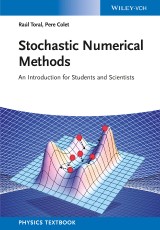Details

Stochastic Numerical Methods
An Introduction for Students and Scientists1. Aufl.
|
76,99 € |
|
| Verlag: | Wiley-VCH (D) |
| Format: | EPUB |
| Veröffentl.: | 26.06.2014 |
| ISBN/EAN: | 9783527683123 |
| Sprache: | englisch |
| Anzahl Seiten: | 416 |
DRM-geschütztes eBook, Sie benötigen z.B. Adobe Digital Editions und eine Adobe ID zum Lesen.
Beschreibungen
<b>Stochastic Numerical Methods</b> introduces at Master level the numerical methods that use probability or stochastic concepts to analyze random processes. The book aims at being rather general and is addressed at students of natural sciences (Physics, Chemistry, Mathematics, Biology, etc.) and Engineering, but also social sciences (Economy, Sociology, etc.) where some of the techniques have been used recently to numerically simulate different agent-based models. <br /><br />Examples included in the book range from phase-transitions and critical phenomena, including details of data analysis (extraction of critical exponents, finite-size effects, etc.), to population dynamics, interfacial growth, chemical reactions, etc. Program listings are integrated in the discussion of numerical algorithms to facilitate their understanding.<br /><br /> <p>From the contents:</p> <ul> <li>Review of Probability Concepts</li> <li>Monte Carlo Integration</li> <li>Generation of Uniform and Non-uniform</li> <li>Random Numbers: Non-correlated Values</li> <li>Dynamical Methods</li> <li>Applications to Statistical Mechanics</li> <li>Introduction to Stochastic Processes</li> <li>Numerical Simulation of Ordinary and</li> <li>Partial Stochastic Differential Equations</li> <li>Introduction to Master Equations</li> <li>Numerical Simulations of Master Equations</li> <li>Hybrid Monte Carlo</li> <li>Generation of n-Dimensional Correlated</li> <li>Gaussian Variables</li> <li>Collective Algorithms for Spin Systems</li> <li>Histogram Extrapolation</li> <li>Multicanonical Simulations</li> </ul>
1. Review of Probability Concepts<br> 2. Monte Carlo Integration<br> 3. Generation of Non-uniform Random Numbers: Non-correlated Values<br> 4. Dynamical Methods<br> 5. Applications to Statistical Mechanics<br> 6. Introduction to Stochastic Processes<br> 7. Numerical Simulation of Stochastic Differential<br> equations<br> 8.Introduction to Master Equations<br> 9. Numerical Simulations of Master Equations<br> 10. Hybrid Monte Carlo<br> 11. Stochastic Partial Differential Equations<br> A. Generation of Uniform ^U (0;<br> 1) Random Numbers<br> B. Generation of n-dimensional Correlated Gaussian<br> Variables<br> C. Calculation of the Correlation Function of a Series<br> D. Collective Algorithms for Spin Systems<br> E. Histogram Extrapolation<br> F. Multicanonical Simulations<br> G. Discrete Fourier Transform<br>
Raul Toral is head of the department of Complex Systems at IFISC (Palma de Mallorca, Spain). He obtained his academic degrees from Barcelona university (Spain), spent two years at THE Physics Department of Edinburgh University (UK), and two more years at Lehigh University (Pennsylvania, USA), before joining the University of Balearic Islands where he has been a full professor since 1994. Prof. Toral has authored 200 scientific publications. He was the director of the Physbio International Summer School on Stochastic Processes in Biology held in St. Etienne de Tinnee (France) in 2006, and a member of the editorial board of Fluctuations and Noise Letters (2005-2007), as well as the organizer of several conferences devoted to basic issues and applications of Nonlinear and Statistical Physics.<br> <br> Pere Colet is Research Professor at IFISC (CSIC-UIB). He obtained his M.Sc. degree in physics from Universitat de Barcelona (1987) and his Ph. D. also in Physics from Universitat de les Illes Balears (1991), Spain. He was a postdoctoral Fulbright fellow at the School of Physics of the Georgia Institute of Tecnology. In May 1995, he joined the Spanish Consejo Superior de Investigaciones Cientificas. He has co-authored over 100 papers in ISI journals as well as 35 other scientific publications. His research interests include fluctuations and nonlinear dynamics of semiconductor lasers, synchronization of chaotic lasers and encoded communications, synchronization of coupled nonlinear oscillators, pattern formation, and quantum fluctuations in nonlinear optical cavities and dynamics of dissipative solitons.<br>
<i>Stochastic Numerical Methods</i> introduces at Master level the numerical methods that use probability or stochastic concepts to analyze random processes. The book aims at being rather general and is addressed at students of natural sciences (Physics, Chemistry, Mathematics, Biology, etc.) and Engineering, but also social sciences (Economy, Sociology, etc.) where some of the techniques have been used recently to numerically simulate different agent-based models. Examples included in the book range from phase-transitions and critical phenomena, including details of data analysis (extraction of critical exponents, finite-size effects, etc.), to population dynamics, interfacial growth, chemical reactions, etc. Program listings are integrated<br /> in the discussion of numerical algorithms to facilitate their understanding.<br /> <br /> From the contents:<br /> • Review of Probability Concepts<br /> • Monte Carlo Integration<br /> • Generation of Uniform and Non-uniform Random Numbers: Non-correlated Values<br /> • Dynamical Methods<br /> • Applications to Statistical Mechanics<br /> • Introduction to Stochastic Processes<br /> • Numerical Simulation of Ordinary and Partial Stochastic Diff erential Equations<br /> •Introduction to Master Equations<br /> • Numerical Simulations of Master Equations<br /> • Hybrid Monte Carlo<br /> • Generation of n-Dimensional Correlated Gaussian Variables<br /> • Collective Algorithms for Spin Systems<br /> • Histogram Extrapolation<br /> • Multicanonical Simulations


















